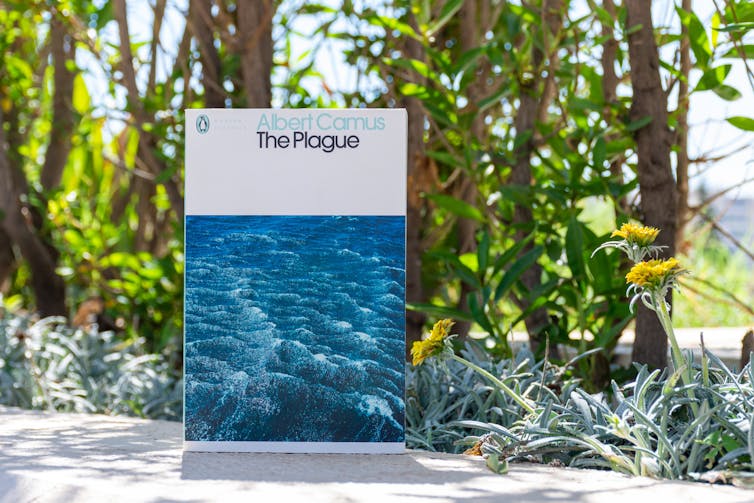GoodStudio/Shutterstock
During the pandemic, reading took on new meaning. People turned to books for comfort. Some read to confront difficult issues, especially following the murder of George Floyd in 2020. Others used reading as a way to care for their children in locked-down houses.
Sales figures and lending data showed a huge spike in people buying and borrowing books. We wanted to follow the stories of real readers and our new book uses a rare combination of literary analysis and qualitative interviewing to capture these dynamics of reception.
While many commentators at the beginning of the pandemic endorsed reading as a straightforward way to relax, our readers showed that the practice morphed and took on new forms and meanings.
Based on hundreds of survey responses and hours of reader interviews from Denmark and the UK, the study makes the interpretation of literature something dynamic and ongoing. And it suggests that readers themselves are agents of meaning, even in the case of novels that seem the most stable in our culture.
Reading during the pandemic showed how books and their meanings change. Novels that we think of as settled in their significance acquire new meaning as they are read under unfolding conditions, exposed to the vagaries of history.
In our research we show how Albert Camus’s The Plague became an unlikely hit in 2020, how the affordances of Sally Rooney’s romantic fiction seemed suddenly to apply to the lovers unable to meet, and how long novels that had intimidated pre-pandemic readers became lifelines in their heft.
Tricky reading
For many people, reading became more difficult during this time.
Far from giving everyone uninterrupted time to attend to long novels by authors like Tolstoy, lockdown exacerbated the separations and challenges of everyday life.
Take Jane Eyre, a novel that many readers picked up during lockdown because it was on their shelves. Suddenly, this classic seemed to be a novel about a woman locked in small rooms and living through a cholera epidemic. Many also took it up under conditions that overlapped directly with the book’s scenes of homeschooling.
One respondent called Phoebe, for instance, deliberately avoided rereading Jane Eyre for these reasons. Charlotte Brontë’s classic novel of loneliness and love was, in 2020, “too creepy”. The story of Jane being locked up made her feel unsafe while she lived alone through lockdown in the confines of her own room.
Another interviewee, Alexandra, was troubled by the idea of reading Hilary Mantel’s bestseller The Mirror and the Light, explaining:
I knew that I would be saying goodbye to Sir Thomas Cromwell […] I looked at it and I thought, what if I die before I get to the end of this? It will be the most unsatisfactory experience.
Rather than sizing up the third part of Mantel’s intimate portrayal of the life of Thomas Cromwell as offering the ideal opportunity for narrative immersion, Alexandra viewed the very thickness of the book as problematic. Her intense fear of death in the pandemic and expectation of Cromwell’s literary demise converge on the length of narrative, which stretches into a future that had become harder to face.
Slipperiness of time
For the reader caught up in a global pandemic, a novel like The Plague, Albert Camus’s famous story of a town suffering a deadly virus, reads differently than it usually would for, say, the school student of French literature. One interviewed reader, for instance, discussed the novel’s temporal slipperiness.
Normally, of course, the very lack of measurable time would suggest the novel as an allegory – untied to a particular time, a warning of dark political forces turning up and spreading at any moment. But in 2020, when time felt like it was moving oddly The Plague’s confused sense of time felt realistic, as if it were mimicking our lived experience of a pandemic.

Hamdi Bendali/Shutterstock
Yet, it would be a mistake to assume all readers suddenly ditched allegory for realism or real-life correspondence. As Kirsten, a Danish woman in her 30s, explained:
I ended up buying The Plague because I was more interested in the metaphorical portrait of the occupation (of France by the Nazis) than in what epidemics do to a society.
By following real readers, our study provides a snapshot of a phenomenal moment in modern history and shows the movement of readers between new purchases and books long kept in their collections. By exploring these varied experiences, we investigated the larger question of how the consumption of novels depends on and shapes people’s experience of non-work time, providing a specific lens through which to examine the experience of reading more generally.
Perhaps most importantly, it demonstrates the dynamic process of reading and the ways in which books change depending on where and when they are read and by whom.
![]()
[email protected] received funding for this project from The Carlsberg Foundation. In summer 2022, he received new funding from the Council for the Defence of British Universities.
[email protected] receives funding from the Carlsberg Foundation











